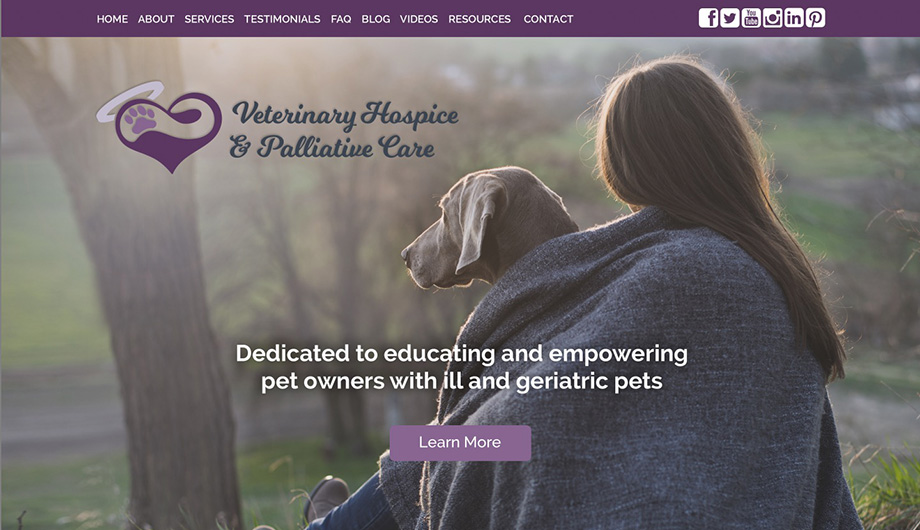
Last week, my niece, Susan’s daughter, graduated from veterinary school. I am a very proud aunt. (And of course Susan is a proud mom.) But that got me thinking about something, and that’s veterinary web design.
I wish I had a lot more experience with veterinary web design, but unfortunately we’ve only made one veterinary website in the past twenty years, and that website has since been retired. We’ve made plenty of dog breeder websites, a few dog kennel websites, event a dog transporter website, but not many veterinary websites. But even though we haven’t made a lot of veterinarian websites, that doesn’t mean I don’t have strong opinions about veterinary web design.
Essential Pages and Their Content:
- Homepage: This is the digital storefront and should immediately convey professionalism and compassion.
- Hero Section: A captivating image or video of happy pets/clients, a clear tagline, and prominent calls to action (e.g., “Schedule Appointment,” “New Patient Info”). Also keep in mind that people really prefer real photos over stock photos, so I recommend getting professional photos taken of your doctor(s) and pets in the office.
- Introduction to the Practice: A brief, welcoming paragraph highlighting the clinic’s unique selling propositions (e.g., compassionate care, advanced technology).
- Key Services Overview: Snapshot of primary services with links to dedicated service pages.
- Testimonials/Reviews: A display of positive client feedback to build trust. If you get good reviews on Google, I recommend using a plugin to import those reviews right into your site. It’s a great way to keep your site updated with recent reviews and Google reviews have more credibility than ones you cherry pick yourself. (And don’t worry, you can set this up not to include any bad reviews, if you had any.)
- Contact Information: Clearly visible phone number, address, and a link to the contact page.
- Emergency Information: Prominent display of emergency contact procedures and hours. I don’t know about other people, but I almost never have an emergency during business hours. Does anyone? Who should your pet parents turn to when your office is closed?
- About Us/Our Team: This page builds trust and personal connection. People want to know who their doctors are, where they went to school, how long they’ve been in practice, how many and what kind of pets they have, etc.
- Our Story: The history and philosophy of the practice.
- Meet Our Team: Individual profiles of veterinarians, technicians, and key staff members with professional photos, bios, and areas of expertise. Is there a practice pet? If so, that pet needs to be included! The first veterinary practice I went to had a house cat (named Baxter) who lived there and he was a staple of the practice.
- Mission/Vision Statement: Articulate the practice’s core values.
- Facility Tour (Optional but Recommended): Photos or a video showcasing the clinic’s environment. People want to look and see your office and know they and their pet will be comfortable there.
- Services: Detail all the veterinary care offered. This should be comprehensive.
- Preventative Care: Vaccinations, wellness exams, parasite control, microchipping.
- Diagnostic Services: Radiology, ultrasound, in-house lab.
- Surgical Services: Spay/neuter, soft tissue, orthopedic.
- Dental Care: Cleanings, extractions, dental radiography.
- Emergency & Urgent Care: Clear instructions on how to proceed.
- Specialty Services: (If applicable) Dermatology, cardiology, oncology, rehabilitation.
- Nutritional Counseling: Dietary advice and prescription diets.
- Pharmacy: Information about in-house or online pharmacy options.
- New Patient Information: Streamline the onboarding process. Are you using a third party system for online scheduling? Do you have an app? All this information should be included.
- What to Expect: Guide for first-time visitors.
- Forms: Downloadable new patient forms (ideally with online submission options).
- Clinic Policies: Payment options, appointment cancellation policies.
- FAQs: Common questions for new clients. This page is SO important. You will eliminate lots of time spent answering questions if you just post the answers on your website. In fact, every website should have this.
- Resources/Pet Health Library: Position the practice as an authoritative source of information. Having a pro-active blog that covers common pet issues is going to be a huge boon to your business. What’s changed in vet med? What are common health issues that people can address at home? What are new changes in guidelines that people need to know? Use your expertise to build a library of articles that not only showcase you as an authority, but help educate your clients on best practicces.
- Educational Articles: On common pet health topics (e.g., puppy care, senior pet health, common diseases).
- FAQs: Broader pet health questions.
- Links to Trusted External Resources: (e.g., AVMA, ASPCA).
- Blog: Regularly updated articles on pet health, clinic news, and community events.
- Contact Us: Make it easy for clients to get in touch.
- Physical Address and Map: Google Maps that can be linked to open the Google maps app is important.
- Phone Number: Clearly displayed and clickable on mobile.
- Email Address/Contact Form: For non-urgent inquiries.
- Operating Hours: Detailed daily schedule, including holiday hours.
- Emergency Contact Information: Reiterate emergency procedures.
Essential Functionality:
Your website needs to look great, and have great information, but it is also important that is has the functionality that you and your clients need.
- Online Appointment Scheduling: An important convenience for modern clients. This could be integrated with existing practice management software or a standalone booking system. (Something like EzVet or Digitail.) Talk to you practice management software vendor to see how much can be integrated into your website. Usually there are scripts or connections that can be used to streamline the process.
- Patient Portal (Optional but Highly Recommended): Secure access for clients to view their pet’s medical records, upcoming appointments, lab results, and medication history.
- Online Pharmacy Integration: If the practice offers an online pharmacy, seamless integration allows clients to order prescriptions and food directly. This can be especially helpful if clients can sign up for recurring subscriptions for their food and medicines they need regularly.
- Responsive Design: The website must be fully optimized for all devices – desktops, tablets, and smartphones. This is paramount for user experience and SEO.
- Search Engine Optimization (SEO): A great veterinary web design includes using relevant keywords, optimizing meta descriptions, and ensuring fast loading times to rank higher in search results.
- Blog/News Section: For regular content updates, improving SEO, and engaging with clients. Make sure to allow comments and questions to engage with your clients.
- Social Media Integration: Links to the practice’s social media profiles. Instagram is a must for veterinary practices, but Facebook is important too. And don’t just create the profiles, you need to be sure that you are using those social outlets to engage with your pet parents.
- Emergency Call-to-Action: A prominent, easily identifiable button or section for emergency contact, especially during off-hours.
- Accessibility Features: Ensuring the website is usable for individuals with disabilities (e.g., alt text for images, keyboard navigation).
- Testimonial Submission Form: Allowing satisfied clients to easily submit reviews. I like to link this directly to Google so people can leave their reviews on Google, which helps with your Google maps placement, your overall rank, and helps build credibility for your practice. And if we do it right, those reviews show up on your website too.
A well-designed veterinary website is more than just an online presence; it’s an indispensable tool for client engagement, education, and practice growth. Investing in comprehensive veterinary web design with the right pages and functionality will significantly enhance the client experience and contribute to the overall success of the veterinary practice.
Click here to see an example homepage of a veterinary web design that we created.
And just because we can, here are photos of Susan and myself, proudly with the graduate at her graduation.


Need help getting your veterinary web design up and running? Contact us today to get a quote and find out how we can help you grow your practice.
Amy Masson
Amy is the co-owner, developer, and website strategist for Sumy Designs. She's been making websites with WordPress since 2006 and is passionate about making sure websites are as functional as they are beautiful.
